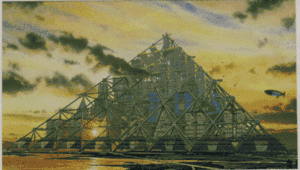Shimizu Mega-City Pyramid
The Shimizu TRY 2004 Mega-City Pyramid is a proposed Shimizu Corporation project for the construction of a massive arcology-pyramid over Tokyo Bay in Japan. The structure would house 1,000,000 people. The structure would be 2,004 meters (6,575 feet) high, including five stacked trusses, each with similar dimensions to that of the Great Pyramid of Giza. This pyramid would help answer Tokyo's increasing lack of space, although the project would only handle a small fraction of the population of the Greater Tokyo Area.[1]
| Shimizu Mega-City Pyramid | |
|---|---|
清水TRY-2004メガシティピラミッド | |
 The Pyramid City arcology or megacity as featured on the Discovery Channel's Extreme Engineering programs | |
| General information | |
| Status | Vision |
| Type | Office, Residential, Research, Leisure |
| Location | Tokyo Bay, Japan |
| Height | |
| Roof | 2,004 m (6,575 ft) |
| Technical details | |
| Floor area | 8 square kilometres (3.1 sq mi) |
| Design and construction | |
| Architect | Dante Bini, David Dimitric |
| Developer | Shimizu Corporation |
The proposed structure is so large that it could not be built with current conventional materials, due to their weight. The design relies on the future availability of super-strong lightweight materials based on carbon nanotubes presently being researched. The plan was to start construction in 2030, but no further action has been taken. Shimizu is still determined to complete the project by 2110, making history as the largest man-made structure in Earth's history.[2]
Materials and construction process
The pyramid's foundation would be formed by 36 piers made of special concrete.
Because the seismically active Pacific Ring of Fire cuts right through Japan, the external structure of the pyramid would be an open network of megatrusses, supporting struts made from carbon nanotubes to allow the pyramid to stand against and let through high winds, and survive earthquakes and tsunamis. The trusses would be coated with photovoltaic film to convert sunlight into electricity and help power the city. The city will also be powered by pond scum or algae.[3]
Robotic systems are planned to play a major part in both construction and building maintenance.[4]
Interior traffic and buildings
Transportation within the city would be provided by accelerating walkways, inclined elevators, and a personal rapid transit system where automated pods would travel within the trusses.
Housing and office space would be provided by twenty-four or more 30-story high skyscrapers suspended from above and below, and attached to the pyramid's supporting structure with nanotube cables.
See also
- Arcology
- Megacity
- Sky City 1000
- X-Seed 4000
- Proposed tall buildings and structures
References
- Statistics Bureau of Japan
- "Tokyo Mega-Pyramid Project, The Future of Cities". Anarchytects. anarchytect1. Retrieved December 22, 2012.
- Alba, Alejandro (January 7, 2015). "5 incredible concept designs of future cities that seem out of this world". New York Daily News. New York Daily News. Retrieved 1 May 2020.
- Van Mead, Nick (June 11, 2019). "Unbuilt Tokyo: 'depthscrapers' and a million-person pyramid". The Guardian. Guardian News & Media Limited. Retrieved 1 May 2020.